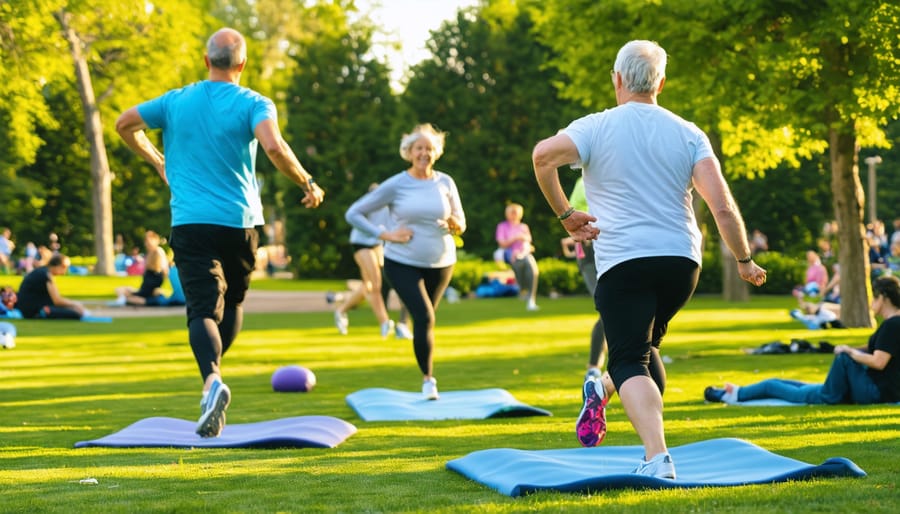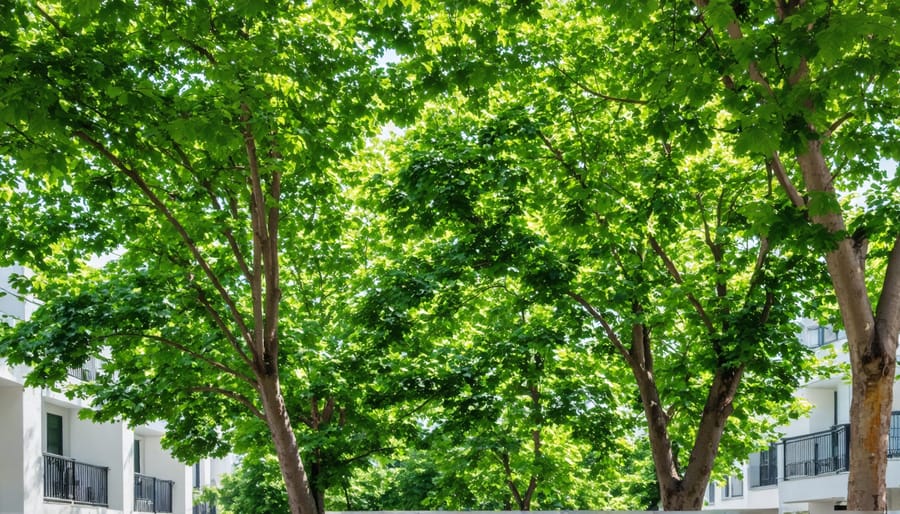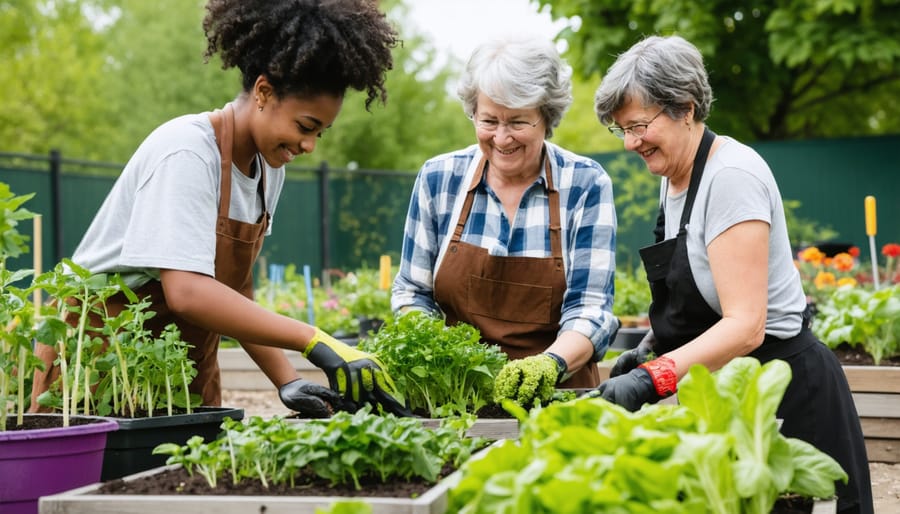In the heart of Australia’s bustling cities, urban green spaces serve as vital lifelines, transforming concrete jungles into thriving ecosystems that benefit both people and planet. From Brisbane’s South Bank Parklands to Melbourne’s Royal Botanic Gardens, these verdant oases do far more than beautify our cityscape – they’re powerful catalysts for community wellbeing and environmental resilience.
Recent studies show that residents living within 300 metres of green spaces experience significantly lower stress levels and better mental health outcomes. These natural sanctuaries filter up to 85% of air pollutants in their immediate vicinity, while helping cool urban areas by up to 4°C during summer heatwaves. For our growing cities, where heat island effects and air quality concerns are mounting, green spaces offer a natural solution that pays dividends across public health, environmental, and economic domains.
Beyond their environmental impact, these spaces foster social connections, with research indicating that urban parks and gardens increase community engagement by up to 40%. For businesses and property developers, proximity to well-maintained green spaces can boost property values by 15-20%, while creating more resilient, liveable neighbourhoods that attract both residents and investors.

Health and Wellbeing Benefits
Mental Health Advantages
In our fast-paced urban lives, the mental health benefits of green spaces serve as a vital sanctuary for wellbeing. Research from Australian universities shows that when you immerse yourself in nature, even for just 15 minutes, your stress hormones significantly decrease, leading to improved mental clarity and emotional balance.
Urban parks and gardens act as natural stress-busters for city dwellers. Whether it’s your local community garden in Melbourne or Brisbane’s City Botanic Gardens, these green havens provide a perfect escape from the concrete jungle. Studies show that residents living near green spaces report lower anxiety levels and better overall mental health compared to those in areas with limited access to nature.
The mental restoration benefits are particularly notable for our urban workforce. A quick lunchtime stroll through a leafy park can boost creativity, improve concentration, and help reset a busy mind. Many Australian businesses are now recognising this, creating green break-out spaces and encouraging employees to spend time outdoors during their workday.
For children and teenagers, regular access to green spaces has been linked to better emotional regulation and reduced symptoms of ADHD. Community gardens and school greening programs across Australia are helping young people develop stronger connections with nature while supporting their mental wellbeing.
Physical Health Impact
Urban green spaces serve as natural fitness hubs, offering Australians endless opportunities for physical activity in refreshing outdoor settings. Whether it’s morning yoga in local parks, weekend cricket matches, or daily walks along tree-lined paths, connecting with natural spaces naturally encourages more active lifestyles.
Research from Australian universities shows that residents living near green spaces are 45% more likely to meet recommended physical activity levels. These spaces provide natural gymnasiums without membership fees, featuring walking trails, exercise stations, and open areas perfect for both structured workouts and casual play.
The air quality benefits of urban green spaces are equally impressive. Our native trees and plants act as natural air filters, removing harmful pollutants and producing clean, oxygen-rich air. Studies in Melbourne and Sydney demonstrate that areas with substantial green coverage experience up to 30% lower levels of air pollution compared to concrete-dominated neighbourhoods.
These green lungs of our cities work tirelessly to trap dust particles and absorb various pollutants, including carbon monoxide and sulfur dioxide. For asthma sufferers and those with respiratory conditions, spending time in these spaces offers welcome relief from urban air pollution. The combination of cleaner air and increased physical activity opportunities makes urban green spaces vital contributors to community health and wellbeing.
Environmental Benefits for Your Community
Urban Heat Island Mitigation
Australian cities face increasing challenges from rising temperatures, with urban heat islands creating hotspots up to 12 degrees warmer than surrounding areas. Green spaces serve as natural cooling systems, offering a practical solution to this growing concern. In Melbourne, studies show that areas with substantial tree cover and parklands can be up to 4 degrees cooler than neighbouring built-up zones during summer heatwaves.
Strategic placement of urban greenery works in multiple ways to combat heat. Tree canopies provide essential shade, while grass and vegetation absorb less heat than concrete and asphalt. Through evapotranspiration, plants release water vapour, creating a natural cooling effect similar to an environmental air conditioner. Cities like Brisbane are leading the way, with initiatives to increase urban forest cover by 40% by 2031, demonstrating how green infrastructure can be integrated into city planning.
Local councils across Australia are embracing innovative solutions, such as green roofs and vertical gardens, to maximise cooling benefits in space-constrained areas. These installations not only reduce building temperatures but also decrease energy consumption for air conditioning. The City of Sydney’s green roofs program has shown that buildings with green installations can reduce cooling costs by up to 25% during summer months.
Communities are also getting involved through neighbourhood greening projects, creating cooler microclimates that benefit entire suburbs. These initiatives show how collective action can transform urban heat islands into comfortable, liveable spaces for all residents.

Biodiversity Enhancement
Urban green spaces serve as vital sanctuaries for Australia’s unique wildlife, creating corridors of life through our concrete jungles. In cities like Melbourne and Sydney, well-designed parks and gardens support an incredible variety of native species, from tiny blue-banded bees to powerful powerful owls.
Local councils across Australia are increasingly incorporating indigenous plant species into their green space designs, providing essential food and shelter for native wildlife. These thoughtful plantings help create stepping stones between larger natural areas, allowing animals to move safely through urban landscapes.
In Brisbane, community gardens and pocket parks have become hotspots for butterfly activity, while Sydney’s urban wetlands provide crucial habitat for migratory birds. Native bee hotels, bird baths, and hollow log installations are becoming common features in our parks, demonstrating how urban green spaces can actively support biodiversity.
The benefits extend beyond wildlife. These biodiverse spaces help maintain healthy ecosystems, supporting natural pest control and pollination services that benefit nearby community gardens and home gardens alike. They also create opportunities for residents to connect with nature, fostering environmental awareness and stewardship.
By incorporating water-sensitive urban design and selecting drought-tolerant native species, these green spaces can thrive while supporting local biodiversity with minimal resource input. This approach helps create resilient urban ecosystems that can better withstand our changing climate while providing habitat for our precious native species.
Social and Economic Advantages
Community Connection
Urban green spaces serve as the heart of Australian communities, creating natural meeting points where neighbours become friends and strangers find common ground. From community gardens in Melbourne’s inner suburbs to Brisbane’s riverside parklands, these green sanctuaries foster meaningful connections that strengthen our social fabric.
Local parks and gardens provide perfect venues for sustainable community activities, from morning tai chi groups to weekend farmers’ markets. These spaces naturally encourage spontaneous interactions – whether it’s parents chatting while their children play on nature playgrounds, or dog owners forming lasting friendships during their daily walks.
Many Australian councils are now designing green spaces with community building in mind, incorporating features like communal BBQ areas, amphitheatres for local performances, and community garden plots. These thoughtful additions create opportunities for residents to gather, share experiences, and develop a stronger sense of belonging.
The impact extends beyond casual meetings. Green spaces often become focal points for community initiatives, such as environmental education programs, cultural celebrations, and neighbourhood clean-up events. They provide neutral ground where people from diverse backgrounds can come together, breaking down social barriers and fostering cross-cultural understanding.
In our increasingly digital world, these natural gathering spaces offer authentic opportunities for face-to-face connection, helping combat social isolation and building more resilient, connected communities.

Property Value Benefits
The presence of urban green spaces has become a significant driver of property values across Australian cities, creating a ripple effect of economic benefits throughout neighbourhoods. Recent studies in Melbourne and Sydney have shown that properties adjacent to parks and gardens typically command 8-15% higher prices than similar properties further away.
Local real estate agents consistently report that proximity to well-maintained green spaces ranks high on homebuyers’ wishlists, particularly among young families and professionals seeking a balanced lifestyle. In Brisbane’s inner suburbs, properties within 500 metres of parklands have experienced value growth rates approximately 20% higher than the suburb average over the past decade.
Beyond individual property values, entire neighbourhoods benefit from the presence of quality green spaces. Streets lined with mature trees, community gardens, and pocket parks create an attractive streetscape that enhances the overall appeal of the area. This “green premium” extends to rental properties as well, with tenants willing to pay more for homes near parks and gardens.
The economic impact isn’t limited to residential properties. Commercial spaces near green areas often see increased foot traffic and higher occupancy rates. Cafes and shops bordering parks in urban centres like Adelaide and Perth report stronger customer engagement and higher revenue compared to similar businesses in purely built-up areas.
Investing in urban green spaces proves to be a win-win situation for councils and property owners alike, delivering both immediate and long-term returns to the community.
Making the Most of Your Local Green Spaces
Getting the most out of your local green spaces doesn’t require elaborate planning or expensive equipment – it’s all about making these natural havens part of your daily routine. Start by exploring local green spaces during different times of the day to discover their unique characteristics and quieter moments.
Create a morning ritual by taking your coffee to a nearby park, or schedule walking meetings through tree-lined paths instead of sitting in an office. Pack a picnic blanket in your work bag for lunch breaks under the shade of native gums, or join a community garden to combine social connection with hands-on nature time.
Make these spaces work for your wellbeing by establishing regular exercise routines – try yoga on the grass, join a local parkrun, or create your own exercise circuit using natural features like stairs and benches. Many councils offer free fitness equipment in parks – why not incorporate these into your workout?
Support your local green spaces by joining Friends of Parks groups or participating in council-led initiatives. Simple actions like picking up litter during your walk, reporting damaged facilities, or participating in community planting days help maintain these valuable spaces for everyone.
For families, turn park visits into learning opportunities by creating nature scavenger hunts, identifying local birds, or collecting fallen leaves for craft projects. Many Australian parks feature indigenous plants – use this as a chance to learn about traditional uses and cultural significance.
Consider adopting a patch of your local park through council programs, or start a neighbourhood group to advocate for improvements and maintenance. Share your favourite spots on community forums, but remember to respect quiet zones and wildlife habitats.
By actively engaging with our urban green spaces, we not only enhance our own wellbeing but help create vibrant, sustainable communities that future generations can enjoy.
The future of our urban green spaces lies in the hands of our communities. From local bushcare groups in Brisbane to community gardens in Melbourne, Australians are increasingly taking ownership of their neighbourhood green spaces. By participating in tree-planting days, joining local environmental groups, or simply using these spaces regularly, we strengthen their value and ensure their preservation for future generations. Local councils across Australia are creating more opportunities for community involvement, from citizen science projects to educational workshops. When we actively engage with our urban green spaces, we not only enhance our own wellbeing but also build stronger, more resilient communities. Together, we can transform our cities into thriving, green sanctuaries that support both people and nature. Let’s make our mark by protecting and nurturing these precious spaces in our urban landscape.
